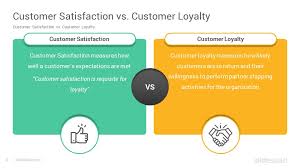Why the Distinction Matters
In the world of sales and marketing, you’ll often hear two terms thrown about interchangeably: customer satisfaction and customer loyalty. They are closely related but they are not the same thing. Whether or not you’re aware of the distinction between them can determine your business strategy, influence your bottom line and assist you in creating a brand that endures the test of time.
With the future of sales increasingly being shaped by AI, data analytics, and automation, it has never been more critical to understand what truly keeps customers coming back.

Defining Customer Satisfaction
Customer satisfaction is a short-term metric that gauges how happy a customer is with a product, service, or interaction. It answers questions like:
- Did the product meet expectations?
- Was the service helpful and timely?
- Was the purchasing experience smooth?
Key Metrics for Measuring Satisfaction:
- Customer Satisfaction Score (CSAT)
- Net Promoter Score (NPS)
- Customer Effort Score (CES)
What Influences Customer Satisfaction?
- Product Quality: Does it perform as promised?
- Service Experience: Is the support helpful and fast?
- User Interface: Is the website or app user-friendly?
Defining Customer Loyalty
Customer loyalty goes deeper. It reflects a customer’s long-term commitment to a brand, often manifesting in repeat purchases, positive word-of-mouth, and even forgiveness of minor issues.
Types of Customer Loyalty:
- Behavioral Loyalty: Repeated purchasing behavior.
- Attitudinal Loyalty: Emotional attachment to the brand.
- Brand Advocacy: Actively promoting the brand to others.
Key Metrics for Measuring Loyalty:
- Customer Retention Rate
- Repeat Purchase Rate
- Customer Lifetime Value (CLV)
The Key Differences Between Satisfaction and Loyalty
| Feature | Customer Satisfaction | Customer Loyalty |
|---|---|---|
| Timeframe | Short-term | Long-term |
| Focus | Experience | Relationship |
| Metrics | CSAT, NPS, CES | CLV, Retention Rate |
| Outcome | Happy momentarily | Returns and recommends |
| Influenced By | Product/Service interaction | Emotional connection, trust |
Why It Matters:
A satisfied customer might not return. A loyal customer not only returns but becomes a brand ambassador. Understanding this helps tailor marketing and service strategies accordingly.
How AI, Data Analytics, and Automation Transform Both
1. AI-Powered Personalization
Using AI, businesses can analyze user behavior and preferences to tailor marketing messages and product recommendations. This enhances both satisfaction and loyalty.
2. Predictive Analytics
Data analytics helps predict customer churn, allowing proactive engagement strategies that turn satisfied customers into loyal ones.
3. Automation Tools
Chatbots, CRM automation, and email workflows streamline customer service and engagement, improving experience without additional human resources.
Real-World Example:
Amazon uses data to recommend products, track satisfaction through feedback, and build loyalty via Prime memberships. The integration of AI and automation has been key to its success.
Strategies to Improve Both Customer Satisfaction and Loyalty
1. Listen Actively
Gather feedback regularly via surveys, social media, and reviews.
2. Deliver Consistent Quality
Never compromise on the product or service quality.
3. Provide Exceptional Customer Service
Train support teams and empower them to solve problems efficiently.
4. Reward Loyalty
Introduce loyalty programs, personalized offers, and special recognition for repeat customers.
5. Leverage Technology
Use AI and data analytics to anticipate customer needs and automate repetitive processes.
Common Pitfalls to Avoid
- Equating Satisfaction with Loyalty: A satisfied customer isn’t always a loyal one.
- Ignoring Feedback: Not acting on feedback can deteriorate trust.
- Lack of Personalization: Generic interactions reduce emotional connection.
- Over-reliance on Discounts: Temporary satisfaction does not lead to long-term loyalty.
Building Future-Proof Customer Relationships
The future of sales marching towards AI, data analytics, and automation — businesses need to keep reminding themselves that they have a lot to do with customer satisfaction, but that is the starting line, not the finish line. The real purpose is to build long term success through customer loyalty.
So although happy customers may enjoy a positive experience, Loyal customers are ambassadors, delivering not just repeat business but also priceless word-of-mouth promotion on your behalf. The companies that understand and leverage this distinction will be the ones to thrive in an increasingly competitive landscape.
Frequently Asked Questions (FAQ)
Q1: Can a customer be satisfied but not loyal?
Yes. A customer might be happy with a purchase but switch brands if a better deal comes along. Loyalty involves a deeper emotional commitment.
Q2: What is more important, satisfaction or loyalty?
Both are important, but loyalty has a greater impact on long-term revenue and brand advocacy.
Q3: How can I turn satisfied customers into loyal ones?
Personalize their experience, reward them, and engage consistently. Use feedback to continuously improve and show that their opinion matters.
Q4: How do AI and automation help with loyalty?
AI helps personalize the customer journey, while automation ensures consistent and timely communication, both of which contribute to stronger loyalty.
Q5: What role does data analytics play?
Data analytics identifies trends, customer behaviors, and potential churn risks, allowing businesses to make informed decisions that enhance both satisfaction and loyalty.